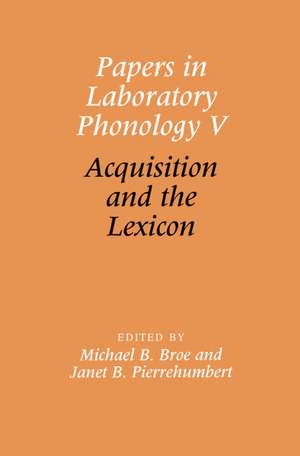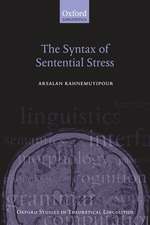Papers in Laboratory Phonology V: Acquisition and the Lexicon: Papers in Laboratory Phonology
Editat de Michael B. Broe, Janet B. Pierrehumberten Limba Engleză Hardback – 12 apr 2000
Preț: 788.96 lei
Preț vechi: 917.40 lei
-14% Nou
Puncte Express: 1183
Preț estimativ în valută:
150.96€ • 157.63$ • 124.66£
150.96€ • 157.63$ • 124.66£
Carte tipărită la comandă
Livrare economică 15-29 aprilie
Preluare comenzi: 021 569.72.76
Specificații
ISBN-13: 9780521643634
ISBN-10: 0521643635
Pagini: 416
Ilustrații: 50 b/w illus.
Dimensiuni: 152 x 229 x 27 mm
Greutate: 0.8 kg
Editura: Cambridge University Press
Colecția Cambridge University Press
Seria Papers in Laboratory Phonology
Locul publicării:Cambridge, United Kingdom
ISBN-10: 0521643635
Pagini: 416
Ilustrații: 50 b/w illus.
Dimensiuni: 152 x 229 x 27 mm
Greutate: 0.8 kg
Editura: Cambridge University Press
Colecția Cambridge University Press
Seria Papers in Laboratory Phonology
Locul publicării:Cambridge, United Kingdom
Cuprins
Part I. General Papers: 1. Coarticulation and physical models of the vocal tract Kevin Munhall, E. Vatikiotis-Bateson, and M. Kawato; 2. Production of Schwa by Japanese speakers of English: an acoustic study of shifts in coarticulatory strategies from L1 to L2 Yuko Kondo; 3. Manner and place conflicts in the articulation of accent in Australian English Jonathan Harrington, Janet Fletcher and Mary Beckman; 4. Phrasal influences on articulatory detail Dani Byrd, Shrikanth Narayanan, Abigail Kaun, and Elliot Saltzman; 5. 'Clocks' and 'glue': global timing and intergestural cohesion Elliot Saltzman, Anders Lofqvist, and Subhorbrath Mitra; 6. Commentary: where is coarticulation? John Coleman; 7. Morphemic invariance and the phonology-phonetics boundary Donca Steriade; 8. Investigating universals of sound change: the effect of vowel height and duration on the development of distinctive nasalization John Hajek and Shinji Maeda; 9. Effects of language experience on perceptual organization of vowel sounds Andrew Lotto, Keith Kluender, and Lori Holt; 10. Commentary: from second thoughts to first principles Bjorn Lindblom; 11. What is a starred tone? Evidence from Greek Amalia Arvaniti, D. Robert Ladd, and Ineke Mennen; 12. The boundary tones are coming: on the nonperipheral realization of boundary tones Carlos Gussenhoven; 13. Lexical versus 'phonological' representations of Mandarin Sandhi tones Shu-hui Peng; 14. Commentary: integrating the phonetics and phonology of tone alignment Jennifer Cole; Part II. Special Topics: 15. Developmental changes in speech perception and early word learning: is there a link? Janet Werker and Christine Stager; 16. Covert contrast as a stage in the acquisition of phonetics and phonology James Scobie, Fiona Gibbon and William Hardcastle; 17. Lexical frequency effects on young children's imitative productions Mary Beckman and Jan Edwards; 18. Developmental changes in infants' sensitivity to internal syllable structure Mara Goodman; Peter Jusczyk, and Angela Bauman; 19. Commentary Jan Edwards; 20. Lexicalization of sound change and alternating environments Joan Bybee; 21. Adults' sensitivity to phonotactic probabilities in English words Rebecca Treiman, Brett Kessler, Stephanie Knewasser, and Ruth Tincoff; 22. Temporally organized lexical representations as phonological units Stefan Frisch; 23. The influence of underspecification and Phoneme frequency in speech perception Rochelle Newman, James Sawusch, and Paul Luce; 24. Commentary: counting, connectionism, and lexical representation Gary Dell.
Descriere
This volume of the series integrates core areas of laboratory phonology with psycholinguistic themes.






















